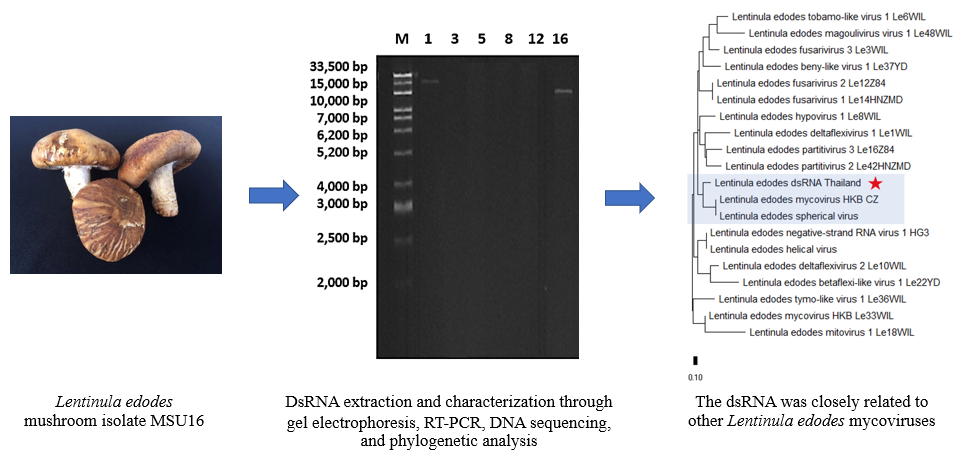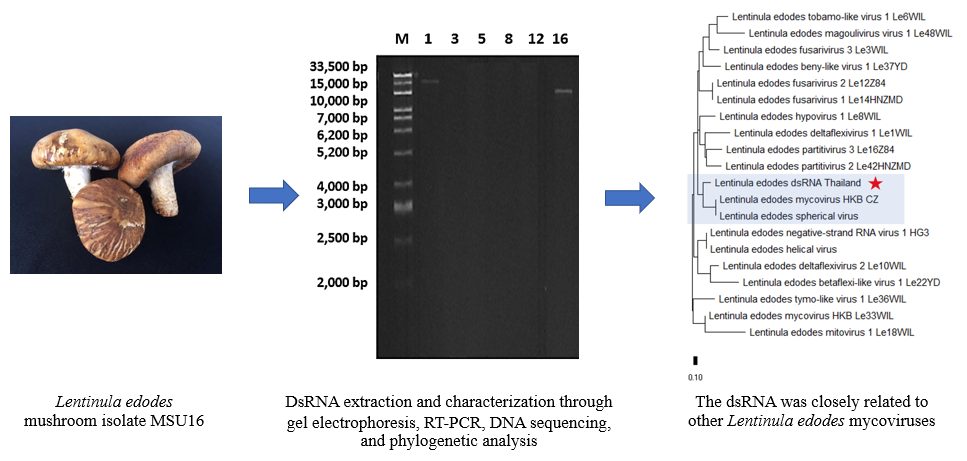Isolation and Identification of dsRNA Mycovirus from Cultivated Mushroom Lentinula edodes
DOI:
https://doi.org/10.48048/tis.2024.7433Keywords:
Economic mushrooms, RT-PCR, Mycovirus, Double-stranded RNA, IdentificationAbstract
Viruses that infect the edible mushroom Lentinula edodes have been documented to exhibit either disease expression or remain asymptomatic. Nonetheless, our knowledge regarding viruses infecting L. edodes, as well as their diversity, remains relatively limited. This research aimed to isolate double-stranded RNA (dsRNA) molecules from 25 economically significant mushrooms using dsRNA extraction and gel electrophoresis techniques. The results revealed the presence of MSU16 dsRNA segments with a size of approximately 10,000 bp in a Lentinula sp. mushroom sample. This substantial dsRNA suggested the possible identification of the virus within the group of Lentinula edodes mycoviruses. Characterization of the MSU16 dsRNA molecule using a 2-step RT-PCR technique, DNA sequencing, and phylogenetic tree analysis based on partial RdRp nucleotide and amino acid sequences indicated a close relationship to other mushroom viruses found in Lentinula sp., with similarity ranging from 39.4 to 64.6 %. Molecular classification of the ITS gene sequence of the dsRNA-detected MSU16 showed a 92 % identity with L. edodes. However, the mushroom MSU16 could not be classified based on the limited LSU gene sequence available in GenBank. This study suggests that the MSU16 dsRNA molecule represents a Lentinula edodes dsRNA mycovirus isolate from Thailand. Our findings contribute valuable information about mycoviral presence in cultivated edible mushrooms.
HIGHLIGHTS
An approximately 10,000 bp dsRNA segment was successfully isolated from the Lentinula edodes mushroom isolate MSU16. This dsRNA was characterized through a 2-step RT-PCR, DNA sequencing, and phylogenetic analysis, focusing on partial RdRp nucleotide and amino acid sequences. The analysis indicated a close relationship between the isolated dsRNA and other viruses known to infect L. edodes mushrooms. Furthermore, the ITS gene sequence of MSU16 exhibited a high similarity to the corresponding ITS sequences in L. edodes.
GRAPHICAL ABSTRACT

Downloads
Metrics
References
H Servi, I Akata and B Çetin. Macrofungal diversity of Bolu Abant Nature Park (Turkey). Afr. J. Biotechnol. 2010; 9, 3622-8.
G Barroso and J Labare`re. Evidence for viral and naked double-stranded RNAs in the basidiomycete Agrocybe aegerita. Curr. Genet. 1990; 18, 231-7.
M Paoletti. Vegetative incompatibility in fungi: From recognition to cell death, whatever does the trick. Fungal Biol. Rev. 2016; 30, 152-62.
JS Park and YH Kim. Infectious RNA viruses in the edible mushroom Pleurotus spp. J. Microbiol. 1996; 34, 61-76.
MN Pearson, RE Beever, B Boine and K Arthur. Mycoviruses of filamentous fungi and their relevance to plant pathology. Mol. Plant Pathol. 2009; 10, 115-28.
K Petrzik, T Sarkisova, J Starý, I Koloniuk, L Hrabáková and O Kubešová. Molecular characterization of a new monopartite dsRNA mycovirus from mycorrhizal Thelephora terrestris (Ehrh.) and its detection in soil oribatid mites (Acari: Oribatida). Virology 2016; 489, 12-9.
MN Pearson, RE Beever, B Boine and K Arthur. Mycoviruses of filamentous fungi and their relevance to plant pathology. Mol. Plant Pathol. 2009; 10, 115-28.
L Angus and LN Donald. Hypovirus molecular biology: From Koch’s Postulates to host self-recognition genes that restrict virus transmission. Adv. Virus Res. 2013; 86, 109-47.
SA Ghabrial, JR Castón, D Jiang, ML Nibert and N Suzuki. 50-Plus years of fungal viruses. Virology 2015; 479-480, 356-68.
TRVD Lende, EH Duitman, MG Gunnewijk, L Yu and JG Wessels. Functional analysis of dsRNAs (L1, L3, L5, and M2) associated with isometric 34-nm virions of Agaricus bisporus (white button mushroom). Virology 1996; 217, 88-96.
CP Romaine and B Schlagnhaufer. Prevalence of double-stranded RNAs in healthy and La France disease-affected basidiocarps of Agaricus bisporus. Mycologia 1989; 81, 822-5.
HM Grogan, BAT Adie, RH Gaze, MP Challen and PR Mills. Double-stranded RNA elements associated with the MVX disease of Agaricus bisporus. Mycol. Res. 2003; 107, 147-54.
DC Eastwood, J Green, H Grogan and KS Burton. Characterizing the viral agents causing brown cap mushroom disease of Agaricus bisporus. Appl. Environ. Microb. 2015; 81, 7125-34.
CP Romaine, B Schlagnhaufer and MM Goodin. Vesicle-associated double-stranded ribonucleic acid genetic elements in Agaricus bisporus. Curr. Genet. 1994; 25, 128-34.
ML Nibert, SA Ghabrial, E Maiss, T Lesker, EJ Vainio, D Jiang and N Suzuki. Taxonomic reorganization of family Partitiviridae and other recent progress in partitivirus research. Virus Res. 2014; 188, 128-41.
RA Valverde, ME Khalifa, R Okada, T Fukuhara and S Sabanadzovic. ICTV virus taxonomy profile: Endornaviridae. J. Gen. Virol. 2019; 100, 1204-5.
PJ Walker, SG Siddell, EJ Lefkowitz, AR Mushegian, EM Adriaenssens, P Alfenas-Zerbini, AJ Davison, DM Dempsey, BE Dutilh, ML García, B Harrach, RL Harrison, RC Hendrickson, S Junglen, NJ Knowles, M Krupovic, JH Kuhn, AJ Lambert, M Łobocka, …, FM Zerbini. Changes to virus taxonomy and to the international code of virus classification and nomenclature ratified by the international committee on taxonomy of viruses. Arch. Virol. 2021; 166, 2633-48.
T Fukuhara, R Koga, N Aoki, C Yuki, N Yamamoto, N Oyama, T Udagawa, H Horiuchi, S Miyazaki, Y Higashi, M Takeshita, K Ikeda, M Arakawa, N Matsumoto and H Moriyama. The wide distribution of endornaviruses, large double-stranded RNA replicons with plasmid-like properties. Arch. Virol. 2006; 151, 995-1002.
H Osaki, H Nakamura, A Sasaki, N Matsumoto and K Yoshida. An endornavirus from a hypovirulent strain of the violet root rot fungus, Helicobasidium mompa. Virus Res. 2006; 118, 143-9.
CV Hacker, CM Brasier and KW Buck. A double-stranded RNA from a Phytophthora species is related to the plant endornaviruses and contains a putative UDP glycosyltransferase gene. J. Gen. Virol. 2005; 86, 1561-70.
S Khankhum, C Escalante, ERD Souto and RA Valverde. Extraction and electrophoretic analysis of large dsRNAs from desiccated plant tissues infected with plant viruses and biotrophic fungi. Eur. J. Plant Pathol. 2016; 147, 431-41.
YJ Zhang, S Zhang, XZ Liu, HA Wen and M Wang. A simple method of genomic DNA extraction suitable for analysis of bulk fungal strains. Lett. Appl. Microbiol. 2010; 51, 114-8.
K Tamura, G Stecher and S Kumar. MEGA 11: Molecular evolutionary genetics analysis version 11. Mol. Biol. Evol. 2021; 38, 3022-7.
HK Won, SJ Park, DK Kim, MJ Shin, N Kim, SH Lee and HS Lee. Isolation and characterization of a mycovirus in Lentinula edodes. J. Microbiol. 2013; 51, 118-22.
JM Kim, SH Yun, S Park, HG Ko and DH Kim. Occurrence of dsRNA mycovirus (LeV-FMRI0339) in the edible mushroom Lentinula edodes and meiotic stability of LeV-FMRI0339 among monokaryotic progeny. Plant Pathol. J. 2013; 29, 460-4.
Y Magae. Molecular characterization of a novel mycovirus in the cultivated mushroom, Lentinula edodes. Virol. J. 2012; 9, 60.
MP Guo, YB Bian, JJ Wang, GZ Wang, XL Ma and ZY Xu. Biological and molecular characteristics of a novel partitivirus infecting the edible fungus Lentinula edodes. Plant Dis. 2017; 101, 726-33.
C Fleming-Archibald, A Ruggiero and H Grogan. Brown mushroom symptom expression following infection of an Agaricus bisporus crop with MVX associated DsRNAs. Fungal Biol. 2015; 119, 1237-45.
Y Magae and M Sunagawa. Characterization of a mycovirus associated with the brown discoloration of edible mushroom, Flammulina velutipes. Virol. J. 2010; 7, 342-9.
L Qiu, Y Li, Y Liu, Y Gao, Y Qi and J Shen. Particle and naked RNA mycoviruses in industrially cultivated mushroom Pleurotus ostreatus in China. Fungal Biol. 2010; 114, 507-13.
TJ Morris and JA Dodds. Isolation and analysis of double-stranded RNA from virus-infected plant and fungal tissue. Phytopathology 1979; 69, 854-8.
RA Valverde, ST Nameth and RL Jordan. Analysis of double-stranded RNA for plant virus diagnosis. Plant Dis. 1990; 74, 255-8.
PK Singh, S Kathuria, K Agarwal, SN Gaur, JF Meis and A Chowdhary. Clinical significance and molecular characterization of nonsporulating molds isolated from the respiratory tracts of Bronchopulmonary Mycosis patients with special reference to Basidiomycetes. J. Clin. Microbiol. 2013; 51, 3331-7.
S Hussain, H Ahmad, S Ullah, N Afshan, DH Pfister, H Sher, H Ali and AN Khalid. The genus Parasola in Pakistan with the description of two new species. MycoKeys 2018; 30, 41-60.
A Porras-Alfaro, KL Liu, CR Kuske and G Xie. From genus to phylum: Large-subunit and internal transcribed spacer rRNA operon regions show similar classification accuracies influenced by database composition. Appl. Environ. Microbiol. 2014; 80, 829-40.
F Liu, SH Wang, DH Jia, H Tan, B Wang and RL Zhao. Development of multiple nucleotide polymorphism molecular markers for enoki mushroom (Flammulina filiformis) cultivars identification. J. Fungi 2023; 9, 330.

Downloads
Published
How to Cite
Issue
Section
License
Copyright (c) 2023 Walailak University

This work is licensed under a Creative Commons Attribution-NonCommercial-NoDerivatives 4.0 International License.






